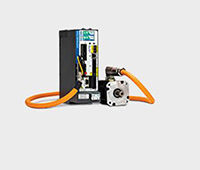
Advantages of Zero-Max’s composite disc couplings include absorbing shock and vibration, misalignment capacity, electrical isolation and elimination of fatigue and fretting.
Special environments and applications require couplings that handle the usual torque transmission and misalignment, but with a few extra features.
Most disc couplings use a metal disc-pack. However, Zero-Max’s composite disc coupling uses a uniquely shaped disc-pack that is constructed of a composite material rather than metal. This composite material offers an alternative to metal disc couplings. Advantages include absorbing shock and vibration, misalignment capacity, electrical isolation and elimination of fatigue and fretting. Metal disc couplings may be less expensive initially, but overall cost of composite disc couplings is usually lower because they are maintenance free and rated for long life.
Accommodating misalignment is a critical aspect of a flexible disc coupling. Misalignment between coupled shafts often exists due to manufacturing tolerances, improper installation or from loads on the system. Engineers should regularly examine lateral, angular and axial misalignment between shafts to see if the coupling selected is up to the task. It is important to know a coupling’s misalignment rating as well as the stiffness rating. The stiffer a coupling, the higher the reaction load misalignment will transmit to the coupled items. These reaction loads will have a negative effect on the life of the system. To limit these reaction loads, the Zero-Max composite disc couplings are less radially stiff than metal disc couplings. Therefore, they transmit lower reaction loads on the coupled equipment, increasing the life of connected components.
How much misalignment a system can handle determines the selection between a single-flex (one flexible disc-pack) and a double-flex (two flexible disc-pack) coupling. While more compact in size than the double-flex variety, a single-flex coupling will have lower misalignment capacity and higher reaction loads. A common misconception is that single-flex disc couplings cannot accommodate lateral misalignment. Although this is true for metal disc couplings, the design of the disc-pack used in the Zero-Max CD coupling allows the single-flex CD coupling to accommodate limited lateral misalignment. This permits designers to use a single-flex disc coupling in designs that may not have space for a double-flex coupling.

Cylindrical bushings allow the attachment of hollow shaft gear reducers and other hollow shaft connections to any metric and inch size solid shaft diameter.
Gear couplings are a type of mechanical device designed to transmit torque between two shafts that are not collinear. The coupling typically consists of two flexible joints, one fixed to each shaft. These joints are often connected by a third shaft called the spindle.
Most joints consists of a 1:1 gear ratio internal/external gear pair. The tooth flanks and outer diameter of the external gear are crowned to allow for angular displacement between the two gears. Mechanically, the gears are equivalent to rotating splines with modified profiles. They are called gears because of the relatively large size of the teeth. Gear couplings are generally limited to angular misalignments of 4 to 5°.
Gear couplings ordinarily come in two variations: flanged sleeve and continuous sleeve. Flanged gear couplings consist of short sleeves surrounded by a perpendicular flange. One sleeve is placed on each shaft so the two flanges line up face to face. A series of screws or bolts in the flanges hold them together. Continuous-sleeve gear couplings use shaft ends coupled together and abutted against each other, which are then enveloped by a sleeve. Often made of metal, these sleeves can also be made of Nylon.
Single-joint gear couplings are used to connect two nominally coaxial shafts. In this application, the device is called a gear-type flexible, or flexible coupling. The single joint allows for minor misalignments such as installation errors and changes in shaft alignment due to operating conditions. These types of gear couplings are generally limited to angular misalignments of 1⁄4 to 1⁄2°.
Magnetic couplings transfer torque without a physical mechanical connection. This makes them suitable for fluid pumping applications because the connection can be made through thin barriers, helping maintain a hermetically sealed rotary feed through.
Because none of the coupling parts are in contact, wear is virtually nonexistent and the use of permanent magnets means no external power source is needed. Magnetic couplings also have a built-in safety feature where, in the event of an overload on the coupling, it will shift to the next position and keep going.
Magnetic couplings can typically only handle light torque loads and applications with either gradual starts, or low rotational inertia of the driven side of the system. They are also rather large in diameter, considering their relatively light torque load. The couplings also have moderate radial loads on support bearings.
Ringfeder Smart Lock
www.ringfeder.com
Zero-Max
www.zero-max.com
Filed Under: Couplings, MOTION CONTROL





Tell Us What You Think!